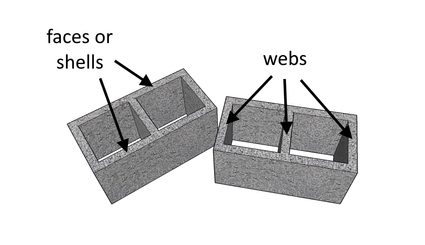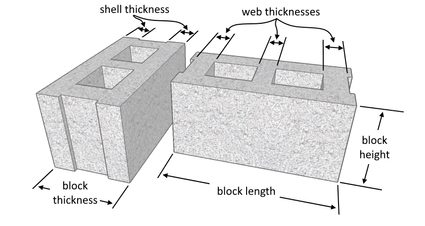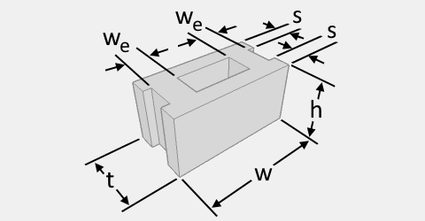Concrete Block Fill Calculator
Table of contents
Should concrete blocks be filled?How much concrete to fill a concrete block?How to use our concrete block fill calculatorConcrete cell fill calculator: sample calculationWant to learn more?FAQsThis concrete block fill calculator (or concrete block core/cell fill calculator) will help you estimate the volume of concrete or mortar needed to fill concrete hollow blocks or cinder blocks while constructing a concrete block wall.
In this calculator, you will learn to calculate how much concrete to fill a cinder block by determining the area and thickness of the wall to be constructed. We will also briefly discuss the common question of "should concrete blocks be filled?" in this text. Keep on reading to learn more.
💡 This tool also works as a concrete block calculator in itself. But if you want to learn more about concrete blocks, we have our separate concrete block calculator you can check out.
Should concrete blocks be filled?
Constructing walls with concrete blocks leads to void spaces within the walls because of the concrete blocks' structure. To achieve the maximum strength that a concrete block wall can potentially have, it would be best to fill these void spaces with concrete or mortar.
Like in most concrete structures, incorporating steel reinforcing bars or rebars will also strengthen the concrete block wall more, especially against cracking. Filling in the cores where the rebars are placed ensures that proper bonding occurs between the concrete block and the rebars and creates a column-like structure throughout the wall's length.
Also, although concrete blocks come in various names like concrete masonry unit or concrete hollow blocks, the steps presented in the next section on how to determine the volume of the filling material will still apply to them. The same goes for cinder blocks (which contain cinders or ashes) or other lightweight concrete blocks as long as their shapes are generally the same.
How much concrete to fill a concrete block?
Since we can buy concrete blocks in different sizes, there will be differences in how much concrete to fill a concrete block. Basically, concrete blocks are made by casting concrete into molds to form two concrete planes or shells that are connected by a series of concrete webbings or webs, as shown below:

In between the webs are void spaces we call cores or cells and these are the spaces that we need to fill with concrete or mortar. By finding the total volume of the cores per block and multiplying it by the number of blocks needed to build the wall, we can determine how much concrete we need to fill an entire wall.
How to use our concrete block fill calculator
Using our concrete block core fill calculator is simple and easy. All you have to do is input the height and width of the wall you plan to build. Then, select the block thickness of the block you wish to use for your wall. This will then cause the corresponding standard thicknesses for the shells & webs and the volume of the filling material you need to be displayed instantly. We have also incorporated wastage to find the total volume of filling material needed while taking into account any material wastage.

We have also set the values for the block height and block length to the standard 20 cm (8 in) x 40 cm (16 in) size blocks. But, you can simply change these values if you are going to use a custom-size block. You can also input custom shell and web thicknesses and select the number of webs in the block depending on your block's specifications. By doing so, you can then calculate the specific core volume per block that you have.
Concrete cell fill calculator: sample calculation
As a sample calculation, let us consider building a 3.0-meter wide and 2.4 meter high wall using 6-inch thick standard 8" × 16" (20 cm × 40 cm) concrete hollow blocks. The core volume of a standard size 6-inch concrete block is approximately 392 in³ or 0.006424 m³.
Now that we have all the details we need, we need to divide the total wall area by the area of a concrete block to find the number of blocks our wall needs:
Number of concrete blocks needed = (wall width × wall height) / (block width × block height)
Number of concrete blocks needed = (3.0 m × 2.4 m) / (0.4 m × 0.2 m)
Number of concrete blocks needed = 7.2 m² / 0.08 m²
Number of concrete blocks needed = 90 concrete blocks
By multiplying the core volume of a single concrete block by the number of concrete blocks needed to build the wall, we can then find the fill volume, as shown below:
Fill volume = core volume per concrete block × number of concrete blocks needed
Fill volume = 0.006424 m³ × 90 concrete blocks
Fill volume = 0.57816 m³
From our calculations above, we can now say that we need around 0.5782 m³ of concrete or mortar to fill the concrete blocks that we will use to construct our wall.
Want to learn more?
After finding how much filling material you need for your wall, you might be asking how much cement, sand, and gravel you need for your mix. You can check out our cement calculator to determine how much of these components you need, depending on whether you want concrete or mortar to fill your wall. You can also check our sand calculator and our gravel calculator if you need to use them as ground bedding for, say, your pavement blocks or an asphalt driveway.
How do I calculate concrete for block fill?
To calculate the volume of concrete, do the following:
- Multiply the inside width of the concrete block with its inside thickness and height.
- Then, multiply this unit volume by the number of concrete blocks.
- Finally, you obtain the ideal volume of concrete to fill your blocks with.
- Don't forget to make a little more concrete — 5% to 10% more — than you have calculated in case there's any spillage.
How much concrete to fill an 8×8×16 inches block?
You will need 550 cubic inches of concrete to fill an 8 × 8 × 16 inches block.
Remember that you want the core volume. This means you need to subtract the dimensions of the shell and webs from your block. You then get the inside width and thickness for your calculations. It looks like this:
inside width × inside thickness × height = (16 − 2 × 1.25 − 1 × 1) × (8 − 2 × 1.25) × 8 = 550 cu in.
How do I calculate the number of bags of cement?
To calculate the number of bags of cement, follow these steps:
-
First, you need to know the volume of cement you will need. Let's say need 2 cubic yards of cement.
-
Then, you must deduce the volume of cement in one bag by dividing its weight by the density of cement. It's well-known that the density of cement is about 94 pounds per cubic foot. Therefore, the volume of cement in one 80-pound bag is:
bag weight / cement density = 80 / 94 = 0.85 cu ft. -
Then, divide the volume of cement you need by the volume in one bag. Convert yards into feet by multiplying by 27.
2 × 27 / 0.85 ≈ 64 bags.You will need about 64 bags to fill a 2-cubic-yard surface with cement.
How many bags of cement do I need for 1 cubic yard?
You can use this table to see how many bags you may need to fill one cubic yard of cement:
Bag weight | Number of bags |
|---|---|
94 lb | 27 |
80 lb | 32 |
60 lb | 42 |
40 lb | 64 |
Example: the number of 94-pound bags of cement needed for 1 cubic yard of cement is 2538 / 94 = 27 bags.
How to dose concrete in a concrete mixer?
The dosage for all-purpose concrete is as follows:
- 1 volume of cement;
- 2 volumes of sand;
- 3 volumes of gravel; and
- ½ volume of water.
To be sure of obtaining equal quantities, use a bucket which, in the calculations, will be equivalent to one volume.

